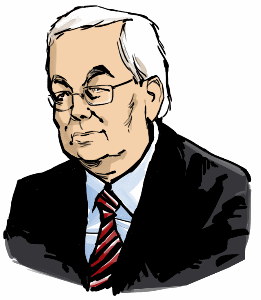Hamlet’s Mill – An Essay on Myth and the Frame of Time
(Giorgio de Santillana)
This is meant to be only an essay. It is a first reconnaissance of a realm well-nigh unexplored and uncharted. From whichever way one enters it, one is caught in the same bewildering circular complexity, as in a labyrinth, for it has no deductive order in the abstract sense, but instead resembles an organism tightly closed in itself, or even better, a monumental “Art of the Fugue.”
The figure of Hamlet as a favorable starting point came by chance. Many other avenues offered themselves, rich in strange symbols and beckoning with great images, but the choice went to Hamlet because he led the mind on a truly inductive quest through a familiar landscape – and one which has the merit of its literary setting. Here is a character deeply present to our awareness, in whom ambiguities and uncertainties, tormented self-questioning and dispassionate insight give a presentiment of the modern mind. His personal drama was that he had to be a hero, but still try to avoid the role Destiny assigned him. His lucid intellect remained above the conflict of motives – in other words, his was and is a truly contemporary consciousness. And yet this character whom the poet made one of us, the first unhappy intellectual, concealed a past as a legendary being, his features predetermined, preshaped by long-standing myth. There was a numinous aura around him, and many clues led up to him. But it was a surprise to find behind the mask an ancient and all-embracing cosmic power – the original master of the dreamed-of first age of the world.
Yet in all his guises he remained strangely himself. The original Amlóði, as his name was in Icelandic legend, shows the same characteristics of melancholy and high intellect. He, too, is a son dedicated to avenge his father, a speaker of cryptic but inescapable truths, an elusive carrier of Fate who must yield once his mission is accomplished and sink once more into concealment in the depths of time to which he belongs: Lord of the Golden Age, the Once and Future King.
This essay will follow the figure farther and farther afield, from the Northland to Rome, from there to Finland, Iran, and India; he will appear again unmistakably in Polynesian legend. Many other Dominions and Powers will materialize to frame him within the proper order.
Amlóði was identified, in the crude and vivid imagery of the Norse, by the ownership of a fabled mill which, in his own time, ground out peace and plenty. Later, in decaying times, it ground out salt; and now finally, having landed at the bottom of the sea, it is grinding rock and sand, creating a vast whirlpool, the Maelstrom (i.e. the grinding stream, from the [Icelandic] verb mala, “to grind”), which is supposed to be a way to the land of the dead. This imagery stands, as the evidence develops, for an astronomical process, the secular shifting of the sun through the signs of the zodiac which determines world-ages, each numbering thousands of years. Each age brings a World Era, a Twilight of the Gods. Great structures collapse; pillars topple which supported the great fabric; floods and cataclysms herald the shaping of a new world. (Hamlet’s Mill – An Essay on Myth and the Frame of Time, 1969; Second Paperback Edition, David R. Godine, Publisher, Boston, 1983, pp. 1-2.)
***
To be, or not to be; that is the question.
(Hamlet, Act III, Sc. i, First folio, 1623.)
5415 = Enter Hamlet.
Hamlet
18050 = To be, or not to be, that is the Question:
19549 = Whether ’tis Nobler in the minde to suffer
23467 = The Slings and Arrowes of outragious Fortune,
17893 = Or to take Armes against a Sea of troubles,
16211 = And by opposing end them: to dye, to sleepe
13853 = No more; and by a sleepe, to say we end
20133 = The Heart-ake, and the thousand Naturall shockes
19800 = That Flesh is heyre too? ‘Tis a consummation
17421 = Deuoutly to be wish’d. To dye to sleepe,
19236 = To sleepe, perchance to Dreame; I, there’s the rub,
19794 = For in that sleepe of death, what dreames may come,
21218 = When we haue shufflel’d off this mortall coile,
20087 = Must giue vs pawse. There’s the respect
13898 = That makes Calamity of so long life:
24656 = For who would beare the Whips and Scornes of time,
24952 = The Oppressors wrong, the poore mans Contumely,
18734 = The pangs of dispriz’d Loue, the Lawes delay,
16768 = The insolence of Office, and the Spurnes
20720 = That patient merit of the vnworthy takes,
17879 = When he himselfe might his Quietus make
21696 = With a bare Bodkin? Who would these Fardles beare
17807 = To grunt and sweat vnder a weary life,
17426 = But that the dread of something after death,
21935 = The vndiscouered Countrey, from whose Borne
20927 = No Traueller returnes, Puzels the will,
19000 = And makes vs rather beare those illes we haue,
20119 = Then flye to others that we know not of.
20260 = Thus Conscience does make Cowards of vs all,
18787 = And thus the Natiue hew of Resolution
21086 = Is sicklied o’re, with the pale cast of Thought,
17836 = And enterprizes of great pith and moment,
22968 = With this regard their Currants turne away,
18723 = And loose the name of Action. Soft you now,
16746 = The faire Ophelia? Nimph, in thy Orizons
9726 = Be all my sinnes remembred.
Ophelia
5047 = Good my Lord,
17675 = How does your Honor for this many a day?
Hamlet
17391 = I humbly thanke you: well, well, well.
714889
To follow:
The Hamlet Myth II – Wisedome crieth without: How long, ye simple ones…
The Hamlet Myth III – Snorri Sturluson’s Murder and Christ’s Mission
***
Reiknivél sem umbreytir stöfum í tölugildi er á netinu:
http://www.light-of-truth.com/ciphersaga.htm

 Gunnar Tómasson
Gunnar Tómasson